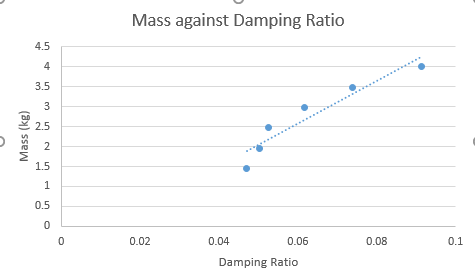I'm currently doing a small project in college for structures being damped. We're adding weights to a structure and measuring the damping affect. We've calculated the damping ratio and coeffecients, however, we currently have damping ratio increasing with mass, which I do not believe is correct following the below equation:
$$\zeta=\frac{c}{2\sqrt{mk}} $$
The above equation, assuming $k$ and $c$ are constant, suggests that $\zeta$ decreases as mass increases.
However, the results we are getting are entirely different, and we do not have a constant value for the damping coefficient:
We got the initial value of damping ratio by interpreting the graphs by using the following equation and process:
$${\sqrt{\frac{\left(\ln \left(\frac{x_n}{x_0}\right)\right)}{4(\pi n)^2+ \left(\ln \left(\frac{x_n}{x_0}\right)\right)}}} = \zeta$$
Where the above was rearranged from:
$$\Large{\frac{x_n}{x_0}= e^{\frac{-2\pi n \zeta }{\sqrt{1-\zeta^2}}}} $$
where $n=$ the number of full wave cycles between $x_0$ and $x_n$
Ultimately, I'm curious if the damping ratio should decrease with increase in mass, and should the damping coefficient stay constant?
Edit 2: Graphs for Unweighted vs 4.004 damping






